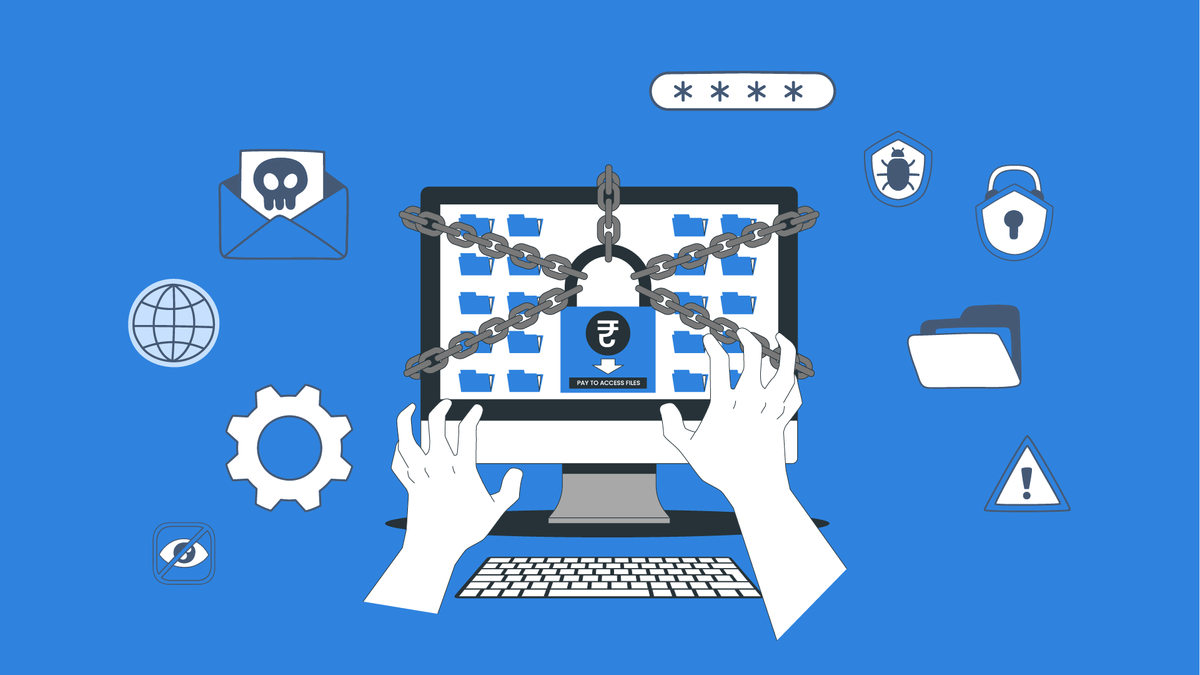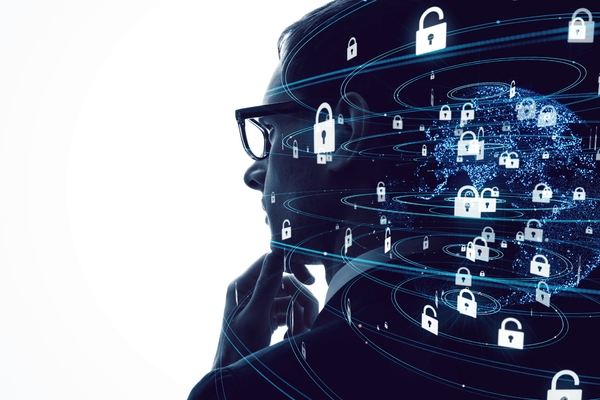All You Need to Know About Ransomware
Ransomware holds data hostage for ransom, often via cryptocurrency. Attackers exploit modern hacking tactics, targeting backups and confidential information, posing significant threats to businesses.

Ransomware is a form of malware in which an individual’s data is held hostage for a monetary exchange. The attacker can have other ulterior motives, too; however, the biggest percentage of ransomware attacks are for extorting money. Attackers have become more advanced with time by using modern hacking tactics to lock the victim’s data.
Recent reports also suggested that many attacks in the past year (2021-2023) targeted backup files/data or confidential information. Such cyber-attacks are becoming prevalent these days, with more hackers working actively to target businesses all over the world. They affect businesses of all sizes and industries. Each one is vulnerable to some extent even after strong protection.
What Is Meant by Ransomware?
When a person’s digital files and data are held hostage through a sophisticated type of malware, it is called ransomware. The victim is locked out of the system till the attacker has achieved their goal. The attack is done using complex algorithms, which bind the system/files and make them inaccessible without a decryption key. The attacker often demands a ransom in the form of cryptocurrencies, which can help the victim get back their system/file access.
Nowadays, modern techniques used for ransomware are exceptionally complex and have more protected encryptions that could be used for double ransom. Double ransom is also rising rapidly where the attacker is holding the data with him and at the same time threatening to leak their personal/confidential data in public. Businesses that need to keep their confidentiality and reputation are often the easier victims who pay off ransoms to keep everything under control. However, this only causes more damage and gives the attacker more authority over the stolen data.
No business is immune to such cyberattacks that are often very damaging and have strict deadlines for the ransom to be paid off. If they do not comply with their demands, they either leak the information to the public, delete the system/data, or increase the ransom amount.
Types of Ransomware
Recently, increasing numbers of ransomware attacks have given us an idea of how complex the situation can be for different kinds of attacks. Ransomware is not limited to simple malware but has deeper roots in cyber extortion.
- Scareware: A fake message or warning will appear on the victim’s phone or computer. This message claims that a virus or malware has been detected in their system and that they need an antivirus solution instantly. The fake links are disguised with payment links and information that might look genuine but is surely not. It is always advised that only reputable software and antivirus solutions should be used, even in cases of non-existent malware.
- Screenlock/screen freeze: This type of cyberattack locks an individual out of their system completely. The PC will not recognize any password, fingerprint, or security questions and will prompt error messages with a demand to pay off a ransom to unlock the system. However, it can be safely bypassed at times by rebooting the system to access those files again. Having a backup for all the important files and data is necessary to avoid losing any data.
- Encrypting ransomware: A very common ransom where the attackers demand cryptocurrencies. The system is locked with algorithms that require a decryption key to be unlocked. There is a higher risk of losing all the data in such attacks.
- Mobile ransomware: Mobiles and tablets are easy targets for hackers and cybercriminals. They are used 24x7 in our dynamism for personal or business purposes, making them more accessible and prone to cyberattacks. Regular security updates, password updates, and OS updates can keep your device safe.
- DDoS extortion: A distributed denial of service is a DDoS attack where the services are halted fully until the ransom amount or any other demand is fulfilled by the victim. With most businesses relying on their digital presence, it is a growing concern that requires robust protection and backup plans to mitigate the immediate threat and continue services of their website/server.
- Doxware/leakware: In this type of cyberattack, the attacker threatens to leak information, media files, or confidential data from the victim’s personal computer. This is not very common but still has been advancing rapidly through AI tools and the usage of anonymity privileges. It is essential to keep your personal information safe and have better knowledge of handling your digital footprint.
With changing digital scenarios and advanced technology, the attackers are becoming more innovative and adapting to modern ways of exploiting and breaching the system. Their knowledge base of cybersecurity loopholes and gaps helps them to create sophisticated ransomware that causes more damage and extracts the information at once.
Examples of Ransomware Attacks
- WannaCry: A Microsoft breach or attack where more than 250,000 systems were affected and left inaccessible until a kill switch was tripped.
- NotPetya: It is considered one of the most brutal ransomware attacks that acts as a wiper and damages the master boot system or where it is attached or encrypted. Even after the ransom is paid in full, the changes will make the data irrecoverable. Only the access and untouched data will be given back.
- Bad Rabbit: The codes and techniques were similar to those of Petya. The visible ransomware was made to target the Russian and Ukrainian media companies to exploit them. However, the only difference was that the system worked fine with the decryption key given by the attacker.
What Trends Are Being Followed by the Attackers?
The cyber era has enabled attackers to pivot to new ways to exploit and break a system without being noticed at all. They stay up to date with the new technology and trends to successfully break into a business data house.
- Global threats and increasing targeted attacks.
- Any business is not safe from such sophisticated malware.
- The extortion stages have been perfected to different levels of techniques.
- Breach frequency has increased due to modern advancements.
- Growing bitcoin popularity led to crypto wars.
What Are the Stages of Ransomware?
Cyberattacks are more damaging and organized than they seem; they have a specific stage for each level of pressure and exploitation.
- Breach: The initial stage of any cyberattack is a system breach when the attack enters a system from weaker entry points.
- Position: The attacker’s next step after entry is making sure that their position is solidified and they can install other malware or lockouts, and entry backdoors for later.
- Reconnaissance: After settling in and taking hold, the attacker will go through every piece of information to understand the structure and vulnerability. Their main goal is to find anything valuable that can be used to extort money.
- Intrusion escalation: The attacker will now try and gain access to every system privilege, which will provide them with more control and further access.
- Extraction/harvesting: The next step is collecting all the data and making copies, storing, and taking hold of sensitive data.
- Attack: This step involves everything that can be used against the victim. Making sure that the impact is maximum and targeted.
- Deploy attack: The final step is to send the ransomware with everything under the attacker’s control, making all the systems inaccessible to the victim.
Why Is It Advised Not to Pay Off a Ransom During a Ransomware Attack?
A business is under pressure and terrified of losing its sensitive data, reputation, and position. This makes them comply with the attacker’s demand and get the decryption key to solve their problems. However, this is not the case with every attack.
Most times, even after completing the payment, the decryption key/code does not work, is faulty, or has an error. The attacker then can demand more money in exchange or threaten to leak their information if the ransom amount is not paid.
Government organizations and the FBI always advise not replying to such ransom attacks and relying on cybercrime police to handle the case. Complying with their demands will encourage future attacks, make them more confident in wrongdoings, and provide them with monetary benefits.
How Can a Business Prevent Ransomware Attacks?
- Learn more about security policies and features when storing your data anywhere online.
- Always use two-factor verification and biometrics to keep your personal/sensitive information safe.
- Install reputed antivirus and storage security software.
- Always use verified antivirus and avoid spam or fishy links.
- The usage of monitoring tools can reduce the chances of such attacks and prevent system breaches.
- Improvise and create backups at different servers for better security with additional firewalls and encryptions.
- It is advised to provide system authority only to the most trusted individual in a business.
- Update system security from time to time to control your digital presence.
- Opt for cybersecurity investments that can safeguard confidential data and help keep the server free of viruses and malware.
Businesses can resume normal operations even after cyberattacks if they have followed a systematic security regime that also provides backup steps and a necessary firewall against attackers. In cases of serious ransomware threats and attacks, it is safer to let the local police and cybercrime organizations handle the situation and find a solution.





